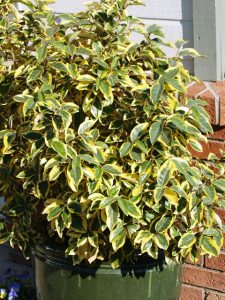By Ken Lain, the mountain gardener

Variegated leaves of bright gold and blue provide interest every month of the year. Growing to head high, she screens out the most obnoxious neighbor while standing up to blistering heat and wind. The super sweet flowers are utterly animal proof, even javelina and deer don’t like the taste of this local shrub. Best planted in the heat of summer for faster growth.
A splendid combination of golden margins on bright green foliage provides fantastic year-round interest in the landscape. A superb hedge or screen requires little maintenance. Tiny, fragrant, silvery flowers in fall are followed by red ornamental berries. Thick evergreen.
Design Ideas:
With its brilliant coloring, this plant is a bright specimen in partial shade gardens in need of excitement. Suitable against darker backgrounds and for welcome color late in the year when flowering plants fade naturally. A great way to interrupt long runs of dull foliage.
Dramatic Foliage Color, Easy Care, Ornamental Berries, Waterwise, Year-round Interest
Botanical Name – Elaeagnus x ebbingei
Common Name – Silverberry
Plant Type – Arizona native shrub or hedge
Mature Size – 4′ wide x 6′ tall
Sun Exposure – Full sun
Soil Type – Sandy, loamy, clay, well-draining
Bloom Time – Fragrant Fall Flowers
Flower Color – white
Hardiness Zones – 7 to 11
Native Area – Arizona
How to Grow Serviceberry
This plant is tough and requires little care once fully rooted in the landscape. Thrives in light, loamy or sandy, well-drained soil with full to part sun, but tolerates a range of conditions including dry shade and poor soil; avoid soggy soils. Water deeply, regularly during the first growing season to establish an extensive root system, reduce frequency once established.
To add it to your garden, loosen the soil about 12 to 15 inches deep and add 3 inches of Watters Premium Mulch blended into the soil. The soil should be well-drained, as Silverberry doesn’t like wet soil. Space plants at 2-3 foot center to grow a quick, thick hedge. Extremely drought tolerant and grows well in poor soil, this plant is ideal for xeriscaping in desert environments.
Light
Prefers full sunlight, but it can grow in partial shade. If the plant doesn’t get enough sunlight, the long, thin stems can become floppy and need to be staked. Best grown in 6+ hours of sun during the growing season.
Soil
Silverberry grows best in dry soils that drain well. It tolerates poor garden soils where few other shrubs thrive. Soils too nutrient-rich encourage aggressive growth.
Usually added to your drip irrigation system until up to the size required, then cut off all further water needs; except in extreme drought.
Temperature and Humidity
Tolerates both hot, humid days, as well as dry drought conditions. This evergreen is tough.
Fertilizer
Serviceberry adapts much like a mountain native. Promote faster growth to hedge height by feeding with Watters 7-4-4 All Purpose Food three times per year in March, July, and October.
Pruning
Prune in March to create a thicker, full evergreen, and promote a more fragrant bloom.
Common Pests and Diseases
Silverberry doesn’t need much attention. Deer, javelina, and rabbits all dislike the evergreen leaves and rarely take notice of even the flowers.
Companion Plants with Silverberry for an Interesting Backyard
Portulaca tolerates the blazing sun, where the neon flowers attract butterflies. Available in red, orange, violet, white, and pink. Great for containers, rock gardens, between sunny stepping-stones, or any hot, dry garden space where nothing else grows. The brighter, the better!
Sunburst Honeylocust – This mountain native cheerfully shouts, “Hello, Spring!” with its glowing yellow leaves. As summer heats up, it settles down to a naturally cool green, only to turn gold again in autumn. This Watters exclusive casts a dappled shade perfect for reading a book or sharing an outdoor meal. Take the sun and wind, yet easy on your time, water, and maintenance, even the fall cleanup is a piece of cake! Impervious to deer.
Moonshine Yarrow – A fuss-free, heat-loving bloomer with large clusters of canary yellow flowers held above ferny, grey foliage, just stunning. Sunny borders and rock gardens are perfect or planted in a mass to create a bold band of color throughout summer. Mountain tough, you can’t kill this perennial that only blooms better year after year. Javelina and rabbit detest the summer blooms.
Halls Japanese Honeysuckle – An outstanding mountain vine with fragrant yellow flowers that loves blooming in the summer heat. Wind, drought, deer, javelina are no problem. Ideal at growing up fences, walls, or as a groundcover. An excellent solution for a fast-growing screen, even in the poorest of soil. Summer is the preferred planting time for this heat lover.

